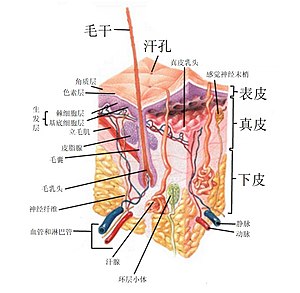立毛肌
立毛肌,亦称为竖毛肌 (Arrector pili muscle)是哺乳动物附着在毛囊上的小块肌肉,这些肌肉的收缩会使毛发直立[1],俗称鸡皮疙瘩(Goose bumps)。目前认为立毛肌在毛囊干细胞微环境的组成中具有重要作用。立毛肌的离断可能是与其连接的毛囊bulge区受损,以及毛囊前体细胞丢失的表现,可以被称为是毛发不可再生的标志[2][3]。此外,毛囊单位中立毛肌的改变与雄激素源性脱发(Androgenetic alopecia、AGA)病程演进的关系受到越来越多的关注[4],而AGA是一种雄激素依赖性疾病,表现为逐渐显著的额颞部和顶部头发细软、密度降低,以及发际线后移[5]。

功能
编辑立毛肌由平滑肌纤维以束状组成,受到自律神经系统的交感神经支配,故其收缩为非自主行为,例如寒冷、恐惧等压力可能会刺激交感神经系统,从而引起收缩。立毛肌的收缩有许多目的。对于大部分的哺乳动物,其主要功能是提供绝缘。空气被截留在直立的毛发之间,从而帮助动物保持热量。豪猪长而浓密的毛发直立使它变得更具威吓性,吓走肉食性动物。皮脂因为立毛肌所施加的压力,被迫沿着毛囊向表面移动,因而保护了头发。
除此之外,目前已有研究发现与立毛肌接触面积越大的毛囊越能持久保持,而与立毛肌接触面积越小的毛囊则更容易受到雄激素的刺激而转变为毫毛[6]。
参考资料
编辑- ^ David H. Cormack. Essential histology 2nd. Lippincott Williams & Wilkins. ISBN 978-0-7817-1668-0.
- ^ Sinclair, R; Torkamani, N; Jones, L. Androgenetic alopecia: new insights into the pathogenesis and mechanism of hair loss.. F1000Research. 2015, 4 (F1000 Faculty Rev): 585 [2020-03-18]. PMID 26339482. doi:10.12688/f1000research.6401.1. (原始内容存档于2020-03-26).
- ^ Torkamani, N; Rufaut, NW; Jones, L; Sinclair, RD. Beyond goosebumps: does the arrector pili muscle have a role in hair loss?. International journal of trichology. 2014-07, 6 (3): 88–94 [2020-03-18]. PMID 25210331. doi:10.4103/0974-7753.139077. (原始内容存档于2020-03-26).
- ^ Torkamani, N; Rufaut, NW; Jones, L; Sinclair, R. Destruction of the arrector pili muscle and fat infiltration in androgenic alopecia.. The British journal of dermatology. 2014-06, 170 (6): 1291–8 [2020-03-18]. PMID 24579818. doi:10.1111/bjd.12921. (原始内容存档于2021-03-01).
- ^ 王璇; 王瑾. 雄激素源性脫髮的機制及藥物治療進展. 临床医药文献电子杂志. 2018, 5 (33): 186–188.
- ^ Sato, A; Toyoshima, KE; Toki, H; Ishibashi, N; Asakawa, K; Iwadate, A; Kanayama, T; Tobe, H; Takeda, A; Tsuji, T. Single follicular unit transplantation reconstructs arrector pili muscle and nerve connections and restores functional hair follicle piloerection.. The Journal of dermatology. 2012-08, 39 (8): 682–7 [2020-03-18]. PMID 22380609. doi:10.1111/j.1346-8138.2012.01505.x. (原始内容存档于2020-03-26).